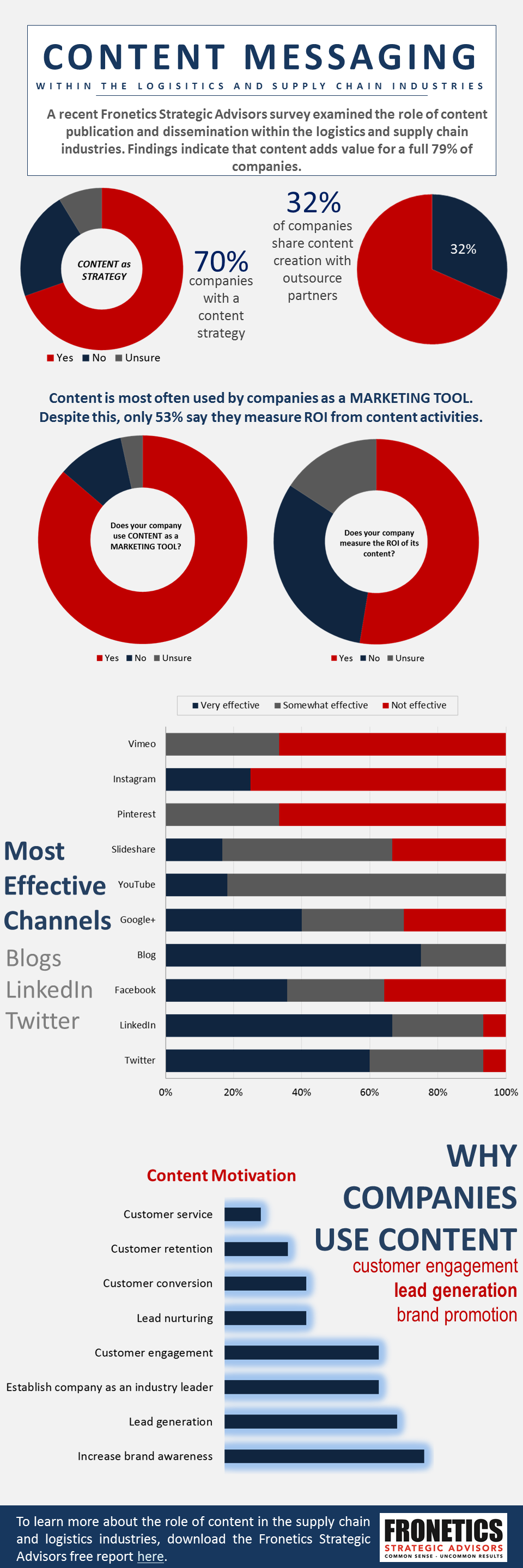
by Fronetics | Mar 31, 2015 | Blog, Content Marketing, Logistics, Marketing, Strategy, Supply Chain
Chief among the determinants of success and failure of companies around the world is the ability to effectively communicate ideas and information. Both internal and external communication play critical roles in advancing business objectives. To be sure, connecting with audiences to convey messaging is a central component of building a solid business strategy. Recent cultural shifts and advances in digital technology have pushed aside traditional methods of communication and given way to the rise of a new type of communication strategy– one that puts content at the very center.
Fronetics Strategic Advisors conducted a survey to better understand the role and use of content within the logistics and supply chain industries.
The survey found that companies within the logistics and supply chain industries are using content as a marketing tool and are realizing benefits.
Survey respondents were asked to identify the goals of their company’s content strategy. The top three goals identified were:
- Increasing brand awareness
- Lead generation
- Establishing the company as an industry leader.
To learn more, check out our infographic, or download the report.


by Fronetics | Feb 18, 2015 | Blog, Content Marketing, Marketing, Strategy

Content curation is an essential component of a marketing strategy.
When it comes to creating and executing a successful marketing strategy, content curation is often forgotten. There are two reasons for this: 1) lack of knowledge about what content curation is; and 2) lack of knowledge about the role of content curation within a marketing strategy.
Here is what you need to know about content curation.
What is content curation?
Simply put, content curation is the act of identifying valuable content from a variety of sources and distributing via it your own platform in a strategic manner.
Heidi Cohen, President at Riverside Marketing Strategies, looked to content marketing experts so as to better understand what content curation is and how it can be used to achieve business objectives. She compiled 19 definitions. Here are three of the definitions:
Content curation is the process of identifying content created by others that will be valuable for your audience and then publishing it on your own platform. Michael Brenner of SAP and the B2B Insider blog.
Content curation is hand selecting content created by other sources and sharing them with your community. Best done when whoever is curating adds their own explanation for sharing, reaction or opinions. C.C. Chapman author of Author of Amazing Things Will Happen and co-author of Content Rules.
Content curation is the process of choosing the most relevant information to meet your readers’ needs on a specific topic like a good editor or museum curator. Content curation requires more than just the selection of information. It’s the assembling, categorizing, commenting and presenting the best content available. Heidi Cohen of Riverside Marketing Strategies.
Why content curation matters
A 2014 survey found that 76% of respondents reported that content curation positively impacted their business goals in 2013. 90% of respondents predicted that content curation will have a positive impact on their business goals in the upcoming year.
No one wants to hear about you all the time. As strange as it may sound, talking about your products, services, and your value all the time is bad for business. Here is where content curation comes in. Content curation will serve to establish your business as a thought-leader within the industry and as a trusted resource. Additionally, it will serve to increase your brand visibility. The great thing about content curation is that it enables you to achieve these business objectives without talking all about you.
Navigating the deluge of digital content available, and identifying the content that is relevant and valuable to your prospects and customers is critical.
Two things to remember:
Quality is key
There is a lot of digital clutter. Steller content curation sorts through the clutter and identifies quality content. Make sure that the content you curate is quality content and not clutter.
Be valuable and relevant
Make sure that every piece of content your curate is content that is both valuable and relevant to your prospects and customers.

by Fronetics | Feb 18, 2015 | Blog, Content Marketing, Marketing, Strategy

Content curation is an essential component of a marketing strategy.
When it comes to creating and executing a successful marketing strategy, content curation is often forgotten. There are two reasons for this: 1) lack of knowledge about what content curation is; and 2) lack of knowledge about the role of content curation within a marketing strategy.
Here is what you need to know about content curation.
What is content curation?
Simply put, content curation is the act of identifying valuable content from a variety of sources and distributing via it your own platform in a strategic manner.
Heidi Cohen, President at Riverside Marketing Strategies, looked to content marketing experts so as to better understand what content curation is and how it can be used to achieve business objectives. She compiled 19 definitions. Here are three of the definitions:
Content curation is the process of identifying content created by others that will be valuable for your audience and then publishing it on your own platform. Michael Brenner of SAP and the B2B Insider blog.
Content curation is hand selecting content created by other sources and sharing them with your community. Best done when whoever is curating adds their own explanation for sharing, reaction or opinions. C.C. Chapman author of Author of Amazing Things Will Happen and co-author of Content Rules.
Content curation is the process of choosing the most relevant information to meet your readers’ needs on a specific topic like a good editor or museum curator. Content curation requires more than just the selection of information. It’s the assembling, categorizing, commenting and presenting the best content available. Heidi Cohen of Riverside Marketing Strategies.
Why content curation matters
A 2014 survey found that 76% of respondents reported that content curation positively impacted their business goals in 2013. 90% of respondents predicted that content curation will have a positive impact on their business goals in the upcoming year.
No one wants to hear about you all the time. As strange as it may sound, talking about your products, services, and your value all the time is bad for business. Here is where content curation comes in. Content curation will serve to establish your business as a thought-leader within the industry and as a trusted resource. Additionally, it will serve to increase your brand visibility. The great thing about content curation is that it enables you to achieve these business objectives without talking all about you.
Navigating the deluge of digital content available, and identifying the content that is relevant and valuable to your prospects and customers is critical.
Two things to remember:
Quality is key
There is a lot of digital clutter. Steller content curation sorts through the clutter and identifies quality content. Make sure that the content you curate is quality content and not clutter.
Be valuable and relevant
Make sure that every piece of content your curate is content that is both valuable and relevant to your prospects and customers.

by Fronetics | Dec 30, 2014 | Blog, Logistics, Manufacturing & Distribution, Marketing, Social Media, Strategy, Supply Chain
 I wrote a guest blog for freight logistics company Cerasis in October which discussed how companies within the manufacturing, supply chain, logistics, and industrial industries can increase their B2B visibility on LinkedIn.
I wrote a guest blog for freight logistics company Cerasis in October which discussed how companies within the manufacturing, supply chain, logistics, and industrial industries can increase their B2B visibility on LinkedIn.
The catalyst for writing the blog were results from a recent survey focused on the supply chain and logistics industry. 58% of respondents rated LinkedIn as “very impactful,” and 37% rated LinkedIn as “somewhat impactful.” At the same time, respondents reported challenges associated with strategy (33%) and a lack of understanding about the application of social media (24%).
Leveraging LinkedIn
There are over 3 million LinkedIn company pages. Being present on LinkedIn is critical, but is not enough. To maximize your LinkedIn presence you need to take steps to increase your B2B visibility. Here’s how:
-
Create a compelling company page
Your company page is an extension of your company. Make sure that the page is compelling, informative, and presents your company as a leader within the industry.
-
Be active
In addition to keeping your company page up-to-date, you need to be active on LinkedIn on a daily basis. LinkedIn groups are great. Actively participating in LinkedIn groups will allow your company to: 1) gain business and market intelligence; 2) introduce you to new, interesting, and relevant topics; 3) help you increase brand awareness; and 4) position your company as an industry leader.
-
Distribute content
If you want your content to be seen you need to get it out there; you need to distribute your content. Distribute your content and curated content via your company page and (when relevant) within the LinkedIn groups to which you belong.
-
Employee engagement
Your employees are your brand ambassadors. Empower your employees to be active within LinkedIn groups as representatives of your company. Encourage employees to share your content and industry content with their connections. Additionally, encourage employees to share open positions with their LinkedIn connections, and to identify great talent within their network.
-
Prospect for leads
LinkedIn is an effective prospecting tool. Use LinkedIn to prospect for leads and to build your sales pipeline.
-
Optimize your profile
Every employee is a reflection of the company. Encourage employees to optimize their personal LinkedIn profiles.
-
Don’t be annoying
You will fail if you take a “me, me, me attitude.” Constantly self-promoting is bad for business.
If your company is not using LinkedIn you are missing out on opportunities and revenue.

by Fronetics | Dec 30, 2014 | Blog, Logistics, Manufacturing & Distribution, Marketing, Social Media, Strategy, Supply Chain
 I wrote a guest blog for freight logistics company Cerasis in October which discussed how companies within the manufacturing, supply chain, logistics, and industrial industries can increase their B2B visibility on LinkedIn.
I wrote a guest blog for freight logistics company Cerasis in October which discussed how companies within the manufacturing, supply chain, logistics, and industrial industries can increase their B2B visibility on LinkedIn.
The catalyst for writing the blog were results from a recent survey focused on the supply chain and logistics industry. 58% of respondents rated LinkedIn as “very impactful,” and 37% rated LinkedIn as “somewhat impactful.” At the same time, respondents reported challenges associated with strategy (33%) and a lack of understanding about the application of social media (24%).
Leveraging LinkedIn
There are over 3 million LinkedIn company pages. Being present on LinkedIn is critical, but is not enough. To maximize your LinkedIn presence you need to take steps to increase your B2B visibility. Here’s how:
-
Create a compelling company page
Your company page is an extension of your company. Make sure that the page is compelling, informative, and presents your company as a leader within the industry.
-
Be active
In addition to keeping your company page up-to-date, you need to be active on LinkedIn on a daily basis. LinkedIn groups are great. Actively participating in LinkedIn groups will allow your company to: 1) gain business and market intelligence; 2) introduce you to new, interesting, and relevant topics; 3) help you increase brand awareness; and 4) position your company as an industry leader.
-
Distribute content
If you want your content to be seen you need to get it out there; you need to distribute your content. Distribute your content and curated content via your company page and (when relevant) within the LinkedIn groups to which you belong.
-
Employee engagement
Your employees are your brand ambassadors. Empower your employees to be active within LinkedIn groups as representatives of your company. Encourage employees to share your content and industry content with their connections. Additionally, encourage employees to share open positions with their LinkedIn connections, and to identify great talent within their network.
-
Prospect for leads
LinkedIn is an effective prospecting tool. Use LinkedIn to prospect for leads and to build your sales pipeline.
-
Optimize your profile
Every employee is a reflection of the company. Encourage employees to optimize their personal LinkedIn profiles.
-
Don’t be annoying
You will fail if you take a “me, me, me attitude.” Constantly self-promoting is bad for business.
If your company is not using LinkedIn you are missing out on opportunities and revenue.





